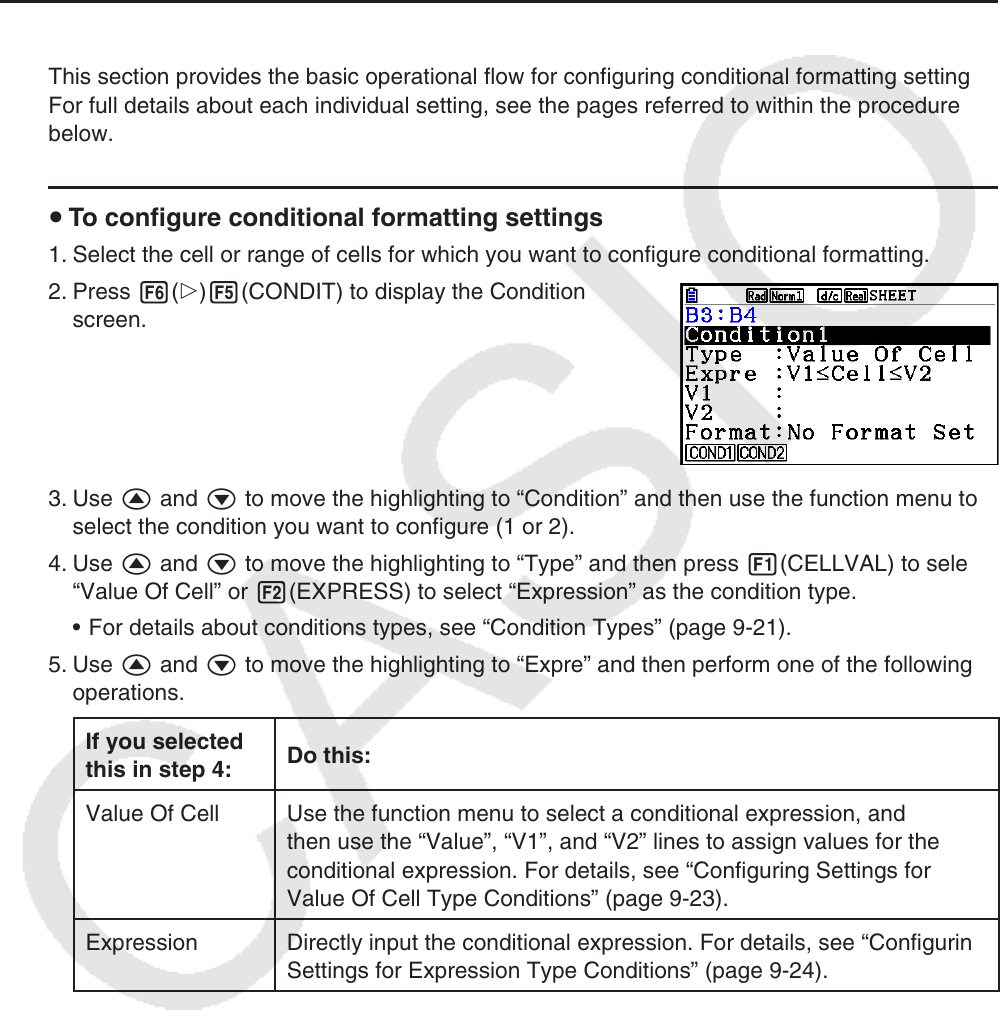User Manual
Table Of Contents
- Contents
- Getting Acquainted — Read This First!
- Chapter 1 Basic Operation
- Chapter 2 Manual Calculations
- 1. Basic Calculations
- 2. Special Functions
- 3. Specifying the Angle Unit and Display Format
- 4. Function Calculations
- 5. Numerical Calculations
- 6. Complex Number Calculations
- 7. Binary, Octal, Decimal, and Hexadecimal Calculations with Integers
- 8. Matrix Calculations
- 9. Vector Calculations
- 10. Metric Conversion Calculations
- Chapter 3 List Function
- Chapter 4 Equation Calculations
- Chapter 5 Graphing
- 1. Sample Graphs
- 2. Controlling What Appears on a Graph Screen
- 3. Drawing a Graph
- 4. Saving and Recalling Graph Screen Contents
- 5. Drawing Two Graphs on the Same Screen
- 6. Manual Graphing
- 7. Using Tables
- 8. Modifying a Graph
- 9. Dynamic Graphing
- 10. Graphing a Recursion Formula
- 11. Graphing a Conic Section
- 12. Drawing Dots, Lines, and Text on the Graph Screen (Sketch)
- 13. Function Analysis
- Chapter 6 Statistical Graphs and Calculations
- 1. Before Performing Statistical Calculations
- 2. Calculating and Graphing Single-Variable Statistical Data
- 3. Calculating and Graphing Paired-Variable Statistical Data (Curve Fitting)
- 4. Performing Statistical Calculations
- 5. Tests
- 6. Confidence Interval
- 7. Distribution
- 8. Input and Output Terms of Tests, Confidence Interval, and Distribution
- 9. Statistic Formula
- Chapter 7 Financial Calculation
- Chapter 8 Programming
- Chapter 9 Spreadsheet
- Chapter 10 eActivity
- Chapter 11 Memory Manager
- Chapter 12 System Manager
- Chapter 13 Data Communication
- Chapter 14 Geometry
- Chapter 15 Picture Plot
- Chapter 16 3D Graph Function
- Appendix
- Examination Mode
- E-CON4 Application (English)
- 1. E-CON4 Mode Overview
- 2. Sampling Screen
- 3. Auto Sensor Detection (CLAB Only)
- 4. Selecting a Sensor
- 5. Configuring the Sampling Setup
- 6. Performing Auto Sensor Calibration and Zero Adjustment
- 7. Using a Custom Probe
- 8. Using Setup Memory
- 9. Starting a Sampling Operation
- 10. Using Sample Data Memory
- 11. Using the Graph Analysis Tools to Graph Data
- 12. Graph Analysis Tool Graph Screen Operations
- 13. Calling E-CON4 Functions from an eActivity

9-22
• Type: Expression
Use this condition type to define a condition based on a formula (such as CelMin(A1:B10)≤C1)
that references one or more cells. This condition type provides a wide range of versatility to set
up conditions such as the ones shown below.
• When A1×30>100, A1 text is blue.
• When CellSum(B1:B30)≤A1, A1 text is blue, and when A1<CellSum(B1:B30), A1 text is red.
k Configuring Conditional Formatting Settings
This section provides the basic operational flow for configuring conditional formatting settings.
For full details about each individual setting, see the pages referred to within the procedure
below.
u To configure conditional formatting settings
1. Select the cell or range of cells for which you want to configure conditional formatting.
2. Press 6(g)5(CONDIT) to display the Condition
screen.
3. Use f and c to move the highlighting to “Condition” and then use the function menu to
select the condition you want to configure (1 or 2).
4. Use f and c to move the highlighting to “Type” and then press 1(CELLVAL) to select
“Value Of Cell” or 2(EXPRESS) to select “Expression” as the condition type.
• For details about conditions types, see “Condition Types” (page 9-21).
5. Use f and c to move the highlighting to “Expre” and then perform one of the following
operations.
If you selected
this in step 4:
Do this:
Value Of Cell Use the function menu to select a conditional expression, and
then use the “Value”, “V1”, and “V2” lines to assign values for the
conditional expression. For details, see “Configuring Settings for
Value Of Cell Type Conditions” (page 9-23).
Expression Directly input the conditional expression. For details, see “Configuring
Settings for Expression Type Conditions” (page 9-24).










